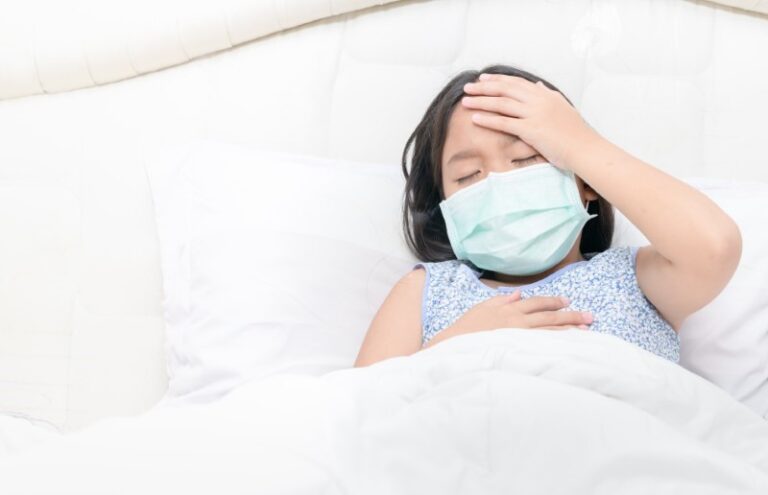Our main objective is to ensure that your child remains in the best of health. Our team is committed to being there for you at every stage of your child’s development and growth. We provide care for a wide range of common childhood conditions, including acute infections, asthma, atopic dermatitis/eczema, allergies, abdominal pain, and many others.
Acute Infections
Children may fall ill occasionally as they are often exposed to various germs, especially in childcare or school. However, as their bodies fight against these infections, they gradually develop immunity. Dr. Yeo is proficient in diagnosing and treating paediatric infections including the common cold, upper respiratory tract infections, sore throat, chest infection, diarrhoea, vomiting, and rashes.vomiting, and rashes.
Common Cold
Don’t let colds bring your child down! Viral infections of the upper respiratory tract can be managed with simple remedies. Try using nasal saline drops and warm baths. However, if your child experiences shortness of breath, high or persistent fever, lethargy, or worsening headache, it’s crucial to seek medical advice right away.
Sore Throat
Pharyngitis or sore throat is a common condition in children, which can be caused by either viral or bacterial infections. Antibiotics are not effective in treating viral pharyngitis, while bacterial pharyngitis requires medication.
Diarrhoea & Vomiting
Diarrhoea and vomiting are common symptoms experienced by adults, children, and babies. They are commonly caused by a stomach bug and usually resolve within a few days. The most important thing is to stay hydrated by drinking lots of fluids to prevent dehydration.
Vomiting is a common early symptom of gastroenteritis. However, most children who experience vomiting and diarrhoea can be treated at home with oral rehydration solutions (ORS). You can also use diluted (half-strength) fresh apple juice. The key is to give very small amounts very frequently. For instance, give 5mls every 5 minutes. As the vomiting improves, you can gradually increase the amount of ORS or apple juice and reduce the frequency of administration. Medicines to treat vomiting or diarrhoea are not necessary or helpful.
If you’re worried that your child is becoming dehydrated, these are signs and symptoms that you should be aware of:
- dry mouth
- sunken eyes
- excessive thirst
- no urine for 8-12 hours or small amounts of dark urine
- lethargy
- no tears when crying.
It’s important to remember that dehydration can be serious, especially in young children. If your child is under six months old, continuously vomiting (especially if the vomit is green or brown), has blood in their stools, or has had diarrhoea for more than 24 hours, seek medical attention as soon as possible.
Urinary Tract Infections
Urinary Tract Infections (UTIs) are common in children, particularly in girls. Symptoms of UTIs include pain, a burning sensation when peeing, smelly, cloudy, or bloody urine, frequent urination, abdominal or back pain, poor feeding, and fever in young children. The good news is that UTIs are easily treatable with antibiotics. However, it is crucial to diagnose and treat UTIs appropriately to prevent any long-term complications.
Bronchiolitis
Bronchiolitis is a common viral chest infection that affects babies and children under 2 years of age. It usually causes mild symptoms such as fast and/or noisy breathing, and difficulty feeding.
However, you should seek medical advice if your child experiences any of the following:
- Difficulty in breathing, grunting noises or their tummy sucking under the ribs
- Poor feeding
- Signs of dehydration, such as fewer nappies than usual
- Your baby is under 3 months old and has a fever (>38 degree Celsius)
- Your baby is more than 3 months old and has a fever (>39 degree Celsius)
- Your child is very tired or irritable
Hand Foot and Mouth Disease
Hand, Foot, and Mouth Disease (HFMD) is caused by a virus known as Coxsackie virus. It results in the appearance of sores around the mouth and throat, as well as a rash on the hands, feet, and sometimes diaper area. Children typically experience a high fever for a few days, which can make them feel very miserable and cause pain while eating.
Symptoms Overview:
However, you should seek medical advice if your child experiences any of the following:
- Fever
- Sore throat
- Painful, blister-like lesions on the tongue, gums, and inside of the cheeks
- Rash on the palms, soles, and sometimes on the buttocks. The rash is not itchy, but may have blisters. Depending on skin tone, the rash could be red, white or grey or only little bumps.
- Loss of appetite
- Peeling of the hands or feet, or even nails failing off, weeks to months after the infection,
There is no specific cure for the condition, but medical care can be provided to manage the symptoms, such as pain relief. It is recommended to drink plenty of fluids to avoid dehydration. Cold dairy products can be soothing for the sores and are usually well-liked by children. Additionally, saltwater mouth rinses, made by mixing 1/2 teaspoon of salt with a glass of warm water, can be used to soothe the discomfort.
It is important to note that your child is most contagious during the first week of HFMD. To prevent the spread of the disease, people with HFMD should limit their exposure to others while they have symptoms. It is advised to keep children with HFMD out of their childcare or school until the fever is gone and mouth sores have healed. If you are unwell, it is best to stay home from work to avoid infecting others.
HFMD is typically a mild viral infection that usually causes fever and mild symptoms for a few days. However, the most common complication of HFMD is dehydration, which can be serious. If your child is younger than six months, has a suppressed immune system, or has mouth sores or a sore throat that makes it painful to drink, it is recommended to seek medical advice. Additionally, if your child’s symptoms do not improve after 10 days, medical attention should be sought.
Asthma & Wheezes
Did you know that asthma is a common childhood illness, affecting nearly 20% of children in Singapore? As a parent, it’s understandable to feel worried when your child is diagnosed with asthma. But don’t worry! Even with this condition, your child can still be healthy and active.
Asthma is a chronic condition that results in the inflammation of airways, making them more sensitive than normal airways. When exposed to triggers, these inflamed airways release chemicals that narrow the airways, causing difficulties in breathing. However, with proper management and treatment, your child can lead a healthy and active life despite having asthma.
Common symptoms of asthma are chest tightness, shortness of breath, cough, and wheezing. Chest tightness may be experienced by older children, especially after intense physical activity. Shortness of breath can be severe enough to interfere with normal daily activities, sleep, or exercise. Asthmatic cough can vary from child to child; some may have a dry cough, while others may have a wet cough that comes with whitish or yellowish phlegm. Wheezing is a whistling sound that occurs when the child breathes out and may not be present in all children.
Asthma can be triggered by various factors, such as allergies, irritants, sudden weather changes, and viral infections. Common allergens that can trigger asthma symptoms include dust, animal fur, pollen, and mold. Although food allergies are uncommon, certain foods like peanuts, eggs, dairy, and bird’s nest can also trigger an asthmatic attack. Exposure to air pollution and cigarette smoke can also be harmful to individuals with asthma. Sudden changes in weather, especially cold and dry air, can also trigger asthmatic symptoms. Additionally, young children who contract viral respiratory infections can develop asthmatic symptoms that may persist for up to two weeks after the infection has cleared.
It’s crucial to keep in mind that every child’s asthma symptoms are unique. To ensure the best care for your little one, it’s recommended to consult with your paediatrician for a personalised management plan.
Abdominal Pain & Constipation
As a parent, it’s natural to worry when your child has a tummy ache. However, you should know that this is a common issue in children and many times it resolves on its own without any treatment.
Most often, the pain is caused by constipation, urinary tract infections, or gastroenteritis, which can be easily treated. Although not common, appendicitis can also be a cause of tummy ache. In many cases of chronic abdominal pain in children, no underlying cause is found, and the pain resolves on its own. Keep in mind that most tummy aches in children are not a cause for concern and can be managed with simple remedies like rest, fluids, and a healthy diet.
Infantile Colic
Infantile colic is a condition that affects healthy infants who are less than four months old, causing them to cry incessantly for an extended period of time, without any known medical conditions. The symptoms of colic include crying that lasts for several hours, which occurs at the same time every day, usually in the late afternoon or early evening, and seems to be without any reason. The infant may move their arms and legs more, clenching their fists and drawing up their legs, and may also expel gas. However, the infant is well at other times.
The root cause of colic is still unknown, but there are some speculated causes. If the infant is formula-fed, they may be allergic to certain proteins in the formula. Lactose malabsorption is another speculated cause, where the infant’s inability to digest certain sugars may lead to poor absorption of these sugars from milk. Additionally, infants can become overwhelmed by external stimuli such as light and sound, especially at the end of the day, leading to overstimulation. In response to the overstimulation, they cry and are not easily soothed.
If you suspect your infant has colic, it is a good idea to talk with a paediatrician. Your doctor can rule out other potential causes, such as intestinal problems or urinary infections, and check that your infant is feeding and growing normally. If your child has colic, your doctor would be able to advise you on your next course of action.
Constipation
Constipation is a common issue that affects infants and children, and it is essential to understand that its aetiology is multifactorial and seldom caused by structural, endocrine, or metabolic diseases.
Painful bowel movements are a common trigger for constipation in children, and it is often due to factors such as toilet training, changes in routine or diet, stressful events, intercurrent illnesses, or delaying defaecation. Constipation can present itself in three common stages of childhood, including during weaning in infancy, while acquiring toilet skills in toddlers, and at school age. It is crucial to note that straining in infants under one year old does not always indicate constipation as they progressively develop muscles to assist bowel movements, provided they pass soft stool and are otherwise healthy.
Constipation is usually diagnosed based on a detailed history and physical examination. Sometimes, blood tests and scans are conducted to exclude treatable causes. In rare cases, a rectal biopsy (a procedure to take a tissue sample from the rectum) may be necessary to diagnose Hirschsprung’s disease, a rare condition that affects the nerves in the bowel.
In most cases, constipation can be successfully treated with a healthy diet consisting of adequate fluids and fiber and, if necessary, laxatives may be prescribed.






